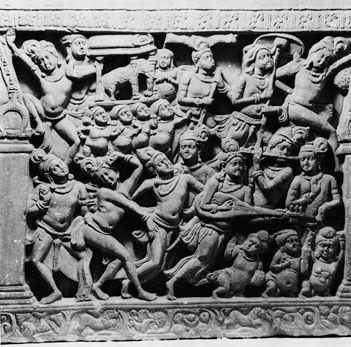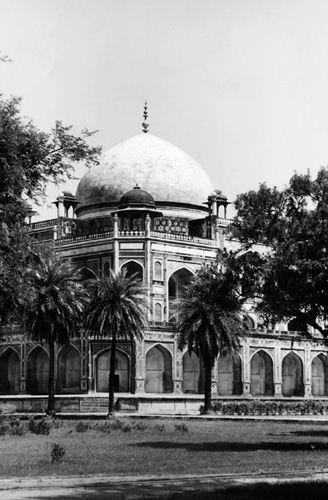India: A History. Revised and Updated (132 page)
Read India: A History. Revised and Updated Online
Authors: John Keay
Tags: #Eurasian History, #Asian History, #India, #v.5, #Amazon.com, #Retail, #History
Relief panel from the Amaravati stupa, originally in Andhra Pradesh, second–third century
AD
. As reconstructed from such illustrations of the original, the Amaravati stupa may have been the greatest monument in Buddhist Asia.

Relief panel from the Amaravati stupa. Early Buddhist narrative scenes do not depict the Buddha in human form but suggest his presence by symbols, like a throne, a footprint or, as here, the Boddhi tree.

Relief panel from the Amaravati stupa, second – third century AD.Musicians and dancers celebrate the descent to earth of a Bodhisattva, or Buddha incarnation.

Exterior of cave temple (no. 2), Badami, Karnataka, late sixth century
AD
. As Vatapi, Badami was adopted by the Chalukya dynasty as the core site of their seventh-to-eighthcentury Deccan empire.

The Jyotirlinga group of temples, Aihole, Karnataka. An inscription here tells of the conquests of Pulakesin II, the Chalukya king who withstood the might of Harsha-vardhana.

The Rajarajeshwara temple at Tanjore, Tamil Nadu, early eleventh century. Largest and loveliest of temples, it was richly endowed by the Chola king Rajaraja I with booty from his peninsular and Sri Lankan conquests.

Sculptural panel from the Chenna Kesava temple, Belur, Karnataka, twelfth century. Traditions of ivory-carving are evident in the statuary of both Dorasamudra (Halebid) and Belur, the twin capitals of the Hoysala dynasty.

Jahaz Mahal (‘Ship Palace’), Mandu, Madhya Pradesh, late fifteenth century. On the heights of Mandu, the sultans of Malwa built fancifully. With its moat full and access only by stepped ‘gangplanks’, this palace appeared to float.

Jaya Stambha (‘Victory Tower’) at Chitor(garh), Rajasthan, 1457—68. It was erected to commemorate the victory of the rajput Rana Kumbha of Mewar (later Udaipur) over Mahmud Khalji, the Muslim sultan of Malwa.

The tomb of Humayun in Delhi, completed 1565. The second of the Great Mughals spent much of his reign in exile in Afghanistan and Persia, whence came the architect of his tomb and its inspiration.

The tomb of Itimad-ud-Daula in Agra, completed 1628. Itimad-ud-Daula was Jahangir’s minister, the father of Nur Jahan (Jahangir’s wife), and the grandfather of both Shah Jahan and his wife Mumtaz Mahal.

Gol Gumbaz (‘Great Tomb’) of Muhammad Adil Shah II in Bijapur, Karnataka, c.1659. Contemporary with the Taj Mahal, but with a dome second only to St Peter’s in Rome, the tomb epitomised the ambitions of the Bijapur sultanate.
